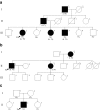A Review of the Genetics of Intracranial Berry Aneurysms and Implications for Genetic Counseling
- PMID: 27743245
- PMCID: PMC5258806
- DOI: 10.1007/s10897-016-0029-8
A Review of the Genetics of Intracranial Berry Aneurysms and Implications for Genetic Counseling
Abstract
Here we review the current understanding of the genetic architecture of intracranial berry aneurysms (IBA) to aid in the genetic counseling of patients at risk for this condition. The familial subtype of IBA, familial intracranial aneurysms (FIA), is associated with increased frequency of IBA, increased risk of rupture, and increased morbidity and mortality after rupture. Family history is the strongest predictor for the development of IBA. However, a genetic test is not yet available to assess risk within a family. Studies using linkage analysis, genome-wide association, and next-generation sequencing have found several candidate loci and genes associated with disease onset, but have not conclusively implicated a single gene. In addition to family history, a separate or concurrent diagnosis of autosomal dominant polycystic kidney disease is a strong genetic risk factor for IBA formation. We also discuss the relative risk for developing IBA in several Mendelian syndromes including vascular Ehlers-Danlos syndrome, Marfan syndrome, Neurofibromatosis Type I, and Loeys-Dietz syndrome.
Keywords: Autosomal dominant polycystic kidney disease; Ehlers-Danlos syndrome; Familial intracranial aneurysms; Genome-wide association study; Intracranial berry aneurysms; Linkage analysis; Loeys-Dietz syndrome; Marfan syndrome; Neurofibromatosis type I; Whole-exome sequencing.
Conflict of interest statement
E.H. and W.T.G. declare they have no conflict of interest. Human Studies and Informed Consent The anonymized FIA pedigrees presented in this article are based on the family histories of patients who have given informed consent to participate in British Columbia Children’s Hospital IRB-approved study H09–01,228. Human subjects were not used for any other component of this manuscript.
Figures

References
-
- Adachi K, Kudo M, Chen MN, Nakazawa S, Wakabayashi I. Cerebral aneurysm associated with multiple endocrine neoplasia, type 1. Neurologia Medico-Chirurgica. 1993;33(5):309–311. - PubMed
Publication types
MeSH terms
LinkOut - more resources
Full Text Sources
Other Literature Sources
Medical
Research Materials

